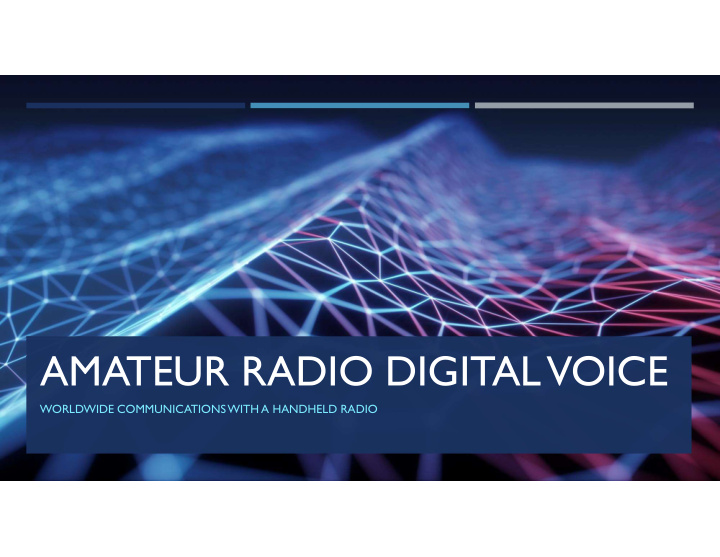



AMATEUR RADIO DIGITAL VOICE WORLDWIDE COMMUNICATIONS WITH A HANDHELD RADIO
AMATEUR RADIO DIGITAL VOICE OVERVIEW What I am not talking about What is Digital Voice? Analogue vs. Digital The Commercial World Standards & Interconnect The Amateur Contenders And the Winner is …. The Practicalities Demonstration
AMATEUR RADIO DIGITAL VOICE WHAT I AM NOT TALKING ABOUT Digital Data Modes (Packet, WSJT etc.) HF Digital (RTTY, CW, Packet) HF Digital Voice
AMATEUR RADIO DIGITAL VOICE WHAT IS DIGITAL VOICE? The conversion of analogue voice waveform into a binary bit stream, the encoding of the bitstream so that it can modulate an RF carrier for transmission and the reverse process to receive the digital transmission. A/D Modulate/ Encode Conversion Transmit D/A Receive/ Decode Conversion Demodulate
AMATEUR RADIO DIGITAL VOICE ANALOGUE VS. DIGITAL Quantization of analogue waveform via A/D converter Resolution based on number of bits (8-12 bits usual) Frequency response dependent on sampling frequency Nyquist theorem states sampling must be done at least 2X the highest frequency to be sampled to eliminate artefacts 3KHz sampled at 6K samples/sec with 10 bit samples = 60K bits/sec! Clever signal processing and math can help —Vocoders Digital Voice Systems Inc. (DVSI) — AMBE+2™ Good quality speech with data rates from 2.0 – 9.6 K bits/sec Encoding adds Forward Error Correction to correct for small errors T echnology used widely satellites, radio, cellular
AMATEUR RADIO DIGITAL VOICE THE COMMERCIAL WORLD As of January 1, 2013 FCC requires all VHF (150-174MHz) and UHF (421-512 MHz) services to be narrowbanded This changed channel spacing from 25 KHz to 12.5 KHz on licence renewal Commercial, Public Safety and Military all have transitioned to digital voice Why digital? The answer is Spectrum Efficiency! The need for data as well as voice Digital communications can also be easily encrypted for security (Military & Public Safety) Standards now exist making equipment from different vendors interoperable APCO-P25, TETRA, DMR, dPMR, NXDN …… The good thing about standards is there are so many of them! Specific use cases e.g. APCO-P25 North American Public Safety Networks, TETRA European Trunked Networks https://www.taitradio.com/__data/assets/pdf_file/0008/156068/Tait_Guide-to-Digital-Radio-Standards-for-Utilities_V1.pdf
AMATEUR RADIO DIGITAL VOICE STANDARDS & INTERCONNECT Why are standards important? • No single vendor can hold the industry to ransom • Lowers the cost of entry so that there is more competition • Allows multi-vendor system configurations to work effectively European T elecommunications Standards Institute (ETSI) a private not for profit organisation responsible for the development and dissemination of communications standards (800 members in 66 countries worldwide) Digital Mobile Radio (DMR) ETSI Standards TS 102 361 Data interconnect via established data standards Internet Protocol (IP) Very complex architectures can be accommodated
AMATEUR RADIO DIGITAL VOICE STANDARDS & INTERCONNECT
AMATEUR RADIO DIGITAL VOICE THE AMATEUR CONTENDERS Amateur radio vendors ICOM and Yaesu enter the digital world Competing standards that attempt to lock you into their equipment ICOM DSTAR jointly developed with Japan Amateur Radio League (JARL) Yaesu Fusion (Continuous Four Frequency Modulation C4FM) Incompatible codecs No alternative sources of equipment Standard, what standards! Amateurs have used commercial equipment in the analogue world why not in the digital world Amateurs have deep pockets but short arms, cost of equipment is extremely important Entry of Chinese vendors in the commercial radio world has radically altered the cost structure E.g. Motorola DMR handheld $800-$1000 — Chinese DMR handheld $120-$200 DMR compatibility due to worldwide standards compliance
AMATEUR RADIO DIGITAL VOICE AND THE WINNER IS …. Digital Mobile Radio (DMR) Worldwide commercial standard ensures compatibility Availability of inexpensive commercial Chinese radios suitable for amateurs Ability to interwork with Fusion (C4FM) easily (1/2 rate modulation) Can work with D-Star with digital conversion/resampling Existing analogue hardware can be used for DMR repeaters (TDM 2 slots, 4FSK Modulation) Availability of low cost hot spots (simplex repeaters) for easy access independent of traditional repeaters Faster growing amateur installed base than either D-Star or Fusion (C4FM)
AMATEUR RADIO DIGITAL VOICE THE PRACTICALITIES …. DMR was designed for commercial use and some ‘massaging’ is needed to warp it for amateur use T erminology learning curve (codeplug, channels, DMR-IDs, zones, time slots, colour, contacts, group/private) DMR repeaters in Australia are mainly in capital cities little penetration in regional areas Repeater access is more tightly controlled due to cost involved (Internet link etc.) Hot spots allow access to the network from anywhere you have Internet service Hot spots costs are controlled by you so access is generally simplified Three distinct worldwide networks (DMR-MARC, DMR+, Brandmeister) require different setups Codeplug generation can be somewhat tedious and confusing at first Some initial pain for a lot of gain
AMATEUR RADIO DIGITAL VOICE THE PRACTICALITIES …. Codeplug Structure Channels Zones Contacts DMR ID, 91 Name, World-Wide Channel, World-Wide Name, World-Wide Frequency Rx/Tx, 439.125 Type, Group Call Mode, DMR BW, 12.5 Slot, 2 Colour, 1 Rx Group, World-Wide
AMATEUR RADIO DIGITAL VOICE THE PRACTICALITIES …. Contacts
AMATEUR RADIO DIGITAL VOICE THE PRACTICALITIES …. Channels
AMATEUR RADIO DIGITAL VOICE THE PRACTICALITIES …. Zone
DEMONSTRATION
Recommend
More recommend